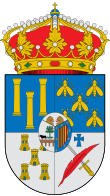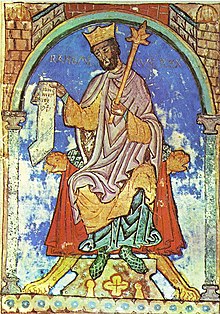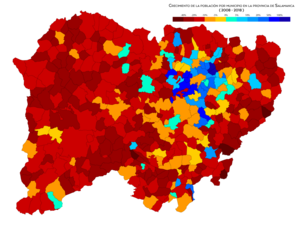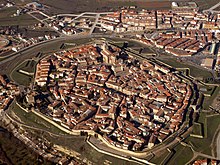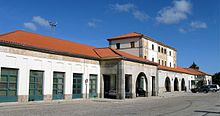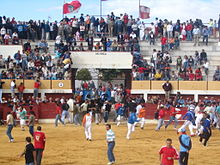Salamanca Province
Salamanca is a Spanish province, located in the southwest of the autonomous community of Castilla y León, with the capital city of Salamanca. It limits with the province of Zamora to the north, with that of Valladolid to the northeast, with that of Ávila to the east, with that of Cáceres to the south and with Portugal to the west. It has an area of &&&&&&&&&&012349.&6000012,349.06 km² and in 2021 it had 327,338 inhabitants.
After the administrative division of 1833, carried out by Javier de Burgos, it was constituted as such, forming part, although without administrative operation, of the region of León. It is divided into 362 municipalities, being the second Spanish province after Burgos By number of municipalities, 11 regions, 27 basic units of planning and services of the territory, 32 associations and 5 judicial districts.
Symbols
Shield
In the first barracks, of blue, three pillars of the ruins of a Roman temple of gold, placed two and one that is the shield of Ciudad Rodrigo; in the second, of blue, five bees of gold set in sotuer that is of Béjar; in the third, of silver, five towers of gold mamposteadas of sable placed in soturan Above all, scuson party, first of all, of silver a stone bridge, mazonado de sable, on which there is an arrested bull of sable, and after it, a fig of siple, pulled; second, of gold with four sticks of gules; embroidery of azur with eight silver pate; cuffed in chief of silver, with two purple lions of Salamanca, to the natural,
Flag
The flag consists of a light purple cloth with the coat of arms used by the Provincial Council.
Geography
The province of Salamanca is located in the northwestern part of the Iberian Peninsula, in the historical region of León and, since 1983, integrated into the autonomous community of Castilla y León. It occupies a geographical area of 12,349.06 km², which makes it the third province of Castilla y León by extension after those of León and Burgos and the sixteenth in Spain. It limits with the province of Zamora to the north, with the province of Valladolid to the northeast, with the province of Ávila to the east, with Extremadura to the south and with Portugal to the west.
| Northwest: Portugal | North: Zamora | Northeast: Valladolid |
| West: Portugal |  | This: Avila |
| SouthwestPortugal | South: Cáceres | Sureste: Avila |
Orography
It has an average altitude of 823 m s. no. m. and there are great differences between some areas and others. With 2428 m s. no. m., the highest point in the province is the peak of Canchal de la Ceja, in the Sierra de Béjar, and with 116 m a.s.l. no. m., the lowest point is the valley of Salto de Saucelle, in the arribes.
Its differentiated geographical entities are the pasture (which occupies the entire area known as Campo Charro), the mountains (Sierras de Gata, Francia-Quilamas and Béjar), the cereal-growing plain (mainly in La Armuña, Tierra de Peñaranda and part of Tierra de Alba), extensive irrigation (Las Villas region) and the arrivals of the Duero, the Tormes, the Uces river, the Huebra and the Águeda (in the regions of La Ribera and El Abadengo).
Hydrography
The hydrographic network of Salamanca is made up mainly of the Duero river basin. Its most important rivers are the Tormes, the Águeda, the Huebra, the Yeltes and the Duero itself. The southeastern rivers belong to the Tagus hydrographic basin. Among them, the Alagón River stands out especially, into which most of the rivers of the northern slopes of the Sierra de Francia-Quilamas and the Sierra de Béjar flow.
Several channels have their flow regulated by swamps, reservoirs and dams. Salamanca, with more than 3,400 hm³, is the third Spanish province with the largest water reservoir capacity, only surpassed by Badajoz and Cáceres. The Almendra dam and reservoir stand out as the highest dam and one of the the largest reservoirs in Spain. Both are part of the Saltos del Duero, a nationally important hydroelectric complex from Zamora-Salmanca. The other dams and reservoirs in the province are those of Águeda, Aldeadávila, Irueña, Navamuño, Riolobos, San Fernando, Santa Teresa, Saucelle and Villagonzalo de Tormes.
Protected natural areas
Throughout the province there are five protected natural areas at the regional level. They are the Arribes del Duero Natural Park, the Las Batuecas - Sierra de Francia Natural Park, the El Rebollar Protected Natural Area, the Sierra de Candelario and the Sierra de las Quilamas. In their entirety, they occupy an area of 210,282 hectares. The Sierras de Francia and Béjar and the Meseta Ibérica have been declared a biosphere reserve.
En la temporada 2020-21, los Oilers terminaron segundos en la División Norte con un récord de 35-19-2, en gran parte debido a una temporada de 105 puntos de Connor McDavid, solo el noveno jugador en alcanzar la marca en 53 juegos.. Además, Leon Draisaitl tuvo una excelente temporada, como subcampeón en anotaciones de la liga NHL, con 84 puntos. La temporada de 105 puntos de McDavid le valió una segunda victoria unánime en el Hart Trophy como el jugador más valioso de la NHL, convirtiéndose en el segundo ganador unánime en la historia de la liga (junto con Wayne Gretzky en 1981–82). Los Oilers se enfrentaron en la primera ronda de los playoffs a los Winnipeg Jets, que terminaron terceros en la División Norte. Los Oilers perdieron cuatro juegos en una barrida ante los Jets, tres de los cuales fueron pérdidas en tiempo extra, incluido el juego final, que se triplicó en tiempo extra. Darnell Nurse registró 62 minutos y 7 segundos de tiempo de hielo en el juego final, el tercero más alto en la historia de la NHL.
Climate
The province has a continental Mediterranean climate with a notable Atlantic influence. It is characterized by its cold and semi-humid winters and its hot and dry summers.
The average annual temperature of the city of Salamanca is around 12 °C. It is one of the provincial capitals with the coldest minimums in Spain in winter.
| Month | Ene. | Feb. | Mar. | Open up. | May. | Jun. | Jul. | Ago. | Sep. | Oct. | Nov. | Dec. | Annual |
|---|---|---|---|---|---|---|---|---|---|---|---|---|---|
| Average temperature (°C) | 3.8 | 5.5 | 7.8 | 9.8 | 13.6 | 18.1 | 21.1 | 20.6 | 17.4 | 12.4 | 7.2 | 4.4 | 11.80 |
| Total precipitation (mm) | 36 | 31.6 | 23.9 | 35.7 | 42.5 | 32.3 | 16.6 | 10.1 | 32.5 | 43.2 | 44.3 | 35.4 | 383.9 |
| Source: Ministry of Agriculture, Food and the Environment. Temperature and precipitation data for the period 1969-1982 at Matacán Airport | |||||||||||||
In Las Arribes there is a Mediterranean microclimate that makes temperatures warmer. It is mainly motivated by the lower altitude in the area. At the Mieza observatory (at 646 m a.s.l.) an average annual temperature of 12.2 °C is recorded, while at the Aldeadávila dam (at 220 m a.s.l.) and at the Saucelle dam (at 116 m a.s.l.) 15 are recorded..5 °C and 17.1 °C respectively. This is especially striking when compared with the data from any Mediterranean city, since they do not differ much (Valencia registers an annual average of 16.9 °C). It is thus, one of the warmest points of the province.
| Month | Ene. | Feb. | Mar. | Open up. | May. | Jun. | Jul. | Ago. | Sep. | Oct. | Nov. | Dec. | Annual |
|---|---|---|---|---|---|---|---|---|---|---|---|---|---|
| Average temperature (°C) | 7.5 | 9.6 | 12.5 | 14.7 | 18.7 | 23.40 | 27.4 | 27.1 | 23.7 | 18 | 11.9 | 8.4 | 16.9 |
| Total precipitation (mm) | 65.3 | 52.6 | 34.9 | 44.8 | 49.5 | 31.5 | 16.3 | 13.5 | 40.3 | 61.7 | 63.5 | 58.8 | 532.6 |
| Source: Ministry of Agriculture, Food and the Environment. Temperature and precipitation data for the period 1969-1982 in the Saucelle Salt | |||||||||||||
The area with the highest rainfall in the province is the mountains. The Sierras de Gata, Francia-Quilamas and Béjar collect around 1000 mm of precipitation per year and are included in what is known as humid Spain. The town of Navasfrías, in El Rebollar (Sierra de Gata), stands out especially as a rainy place. The Vitigudino region is also quite humid, registering an average of 700 mm per year. On the contrary, the least rainy area, with about 400 mm per year, is the region of Las Villas and the area surrounding the city of Salamanca.
| Month | Ene. | Feb. | Mar. | Open up. | May. | Jun. | Jul. | Ago. | Sep. | Oct. | Nov. | Dec. | Annual |
|---|---|---|---|---|---|---|---|---|---|---|---|---|---|
| Average temperature (°C) | 7.5 | 8.5 | 9.6 | 12.6 | 15.5 | 20.7 | 25.7 | 26.3 | 22.1 | 16.5 | 11.6 | 7.4 | 15.3 |
| Total precipitation (mm) | 207.7 | 200.7 | 123.6 | 93.7 | 138.8 | 59.2 | 18.9 | 12.3 | 58.9 | 138.0 | 141.2 | 212.7 | 1405.6 |
| Source: Ministry of Agriculture, Food and the Environment. Temperature and precipitation data for the period 1969-1982 in Mogarraz | |||||||||||||
History
Old Age
In the territory of the current Spanish provinces of Ávila and Salamanca, and in part of those of Cáceres, Toledo and Zamora, the Vetones were settled, a pre-Roman people of Celtic culture of which there are numerous archaeological remains throughout the province. Several localities have a Veton origin. Some of them important. This is the case of Salamanca (Salmantica), Ledesma (Bletisama) and Ciudad Rodrigo (Augustobriga).
Their towns used to be established on the banks of rivers and/or on hills. Salamanca and Ledesma can be cited following the course of the Tormes, Bermellar, El Castillo (Saldeana), Moncalvo (Hinojosa de Duero), Picón de la Mora (Picones) and Yecla la Vieja (Yecla) next to the Huebra, Ciudad Rodrigo, Irueña (Fuenteguinaldo) and Lerilla (Zamarra) on a breakwater on the banks of the Águeda and Las Merchanas (Lumbrales), in a meander of the Camaces.
What would later become the Roman road to La Plata, must have been a path previously traveled by the Tartessians, due to the tin trade. This would explain the proximity of the large archaeological complex of Berrueco, located near El Tejado and built as an acropolis.
One of the most striking legacies of the vetones are the verracos, stone sculptures in the shape of a bull or pig found in various parts of the province. Its function has always been highly debated. What is clear is that they denote the importance of cattle in this culture.
The area located between La Armuña and the Salamanca peneplain marked the border between Vetones and Vacceos, the other pre-Roman town in the province. He was based in a small part of the northeast sector. The city of Salamanca (Salmantica) was founded by the Vetones, but when it was attacked by Hannibal in 220 BC. C. appears identified as a vaccean city (Helmantica).
Roman rule
After the progressive expansion of Roman rule throughout the Iberian Peninsula, the territory of the current province of Salamanca was integrated into the Roman Empire within the province of Lusitania, within the conventus iuridicus Emeritense. At this time, the importance of Salmántica, Bletisa and Miróbriga stood out, the first located on the Vía de la Plata, the main Roman communication axis that crossed the Spanish West. The Roman bridge of Salamanca, the three columns of Ciudad Rodrigo, the Mocho de Ledesma Bridge, or the numerous stelae and inscriptions existing throughout the province are testimony to this historical period.
The gold exploitations of the Cavenes de El Cabaco and El Maíllo were also important.
Middle Ages
After the fall of Rome, the Alans settled on the old Vetton site, being replaced in control of current Salamanca by the Visigoths, with whom the city of Salamanca was already the episcopal seat.
The Muslim invasion of the Iberian Peninsula at the beginning of the VIII century, threw the Visigoths out of control of these lands, The last Gothic king, Rodrigo, was fighting his last battle in the lands of the current province of Salamanca, in Segoyuela de los Cornejos. Thus, Salamanca was left in the area called "no man's land", an extensive geographical area located between the Central System and the Cantabrian Mountains, which remained semi-despopulated at this time.
This fact did not prevent the Christians from the north from carrying out incursions into this area, such as those carried out by Alfonso I Ordoño and Alfonso III of Asturias. The Christian reconquest of Salamanca was delayed until Ramiro II of León in 939 defeat Abderramán III in the battles of Simancas and Alhandega, repopulating several nuclei in the north of the province such as Salamanca, Ledesma or Guadramiro.
After Ramiro II's first repopulation attempt on the right bank of the Tormes, which according to Antonio Llorente must have been of little importance, the territory of Salamanca was exposed to a series of aceifas by Almanzor's Muslim troops at the end of century X.
It was the subsequent repopulations, which came hand in hand with Alfonso VI and Fernando II de León, that created most of the current towns in the province. Of these monarchs, Alfonso VI granted privileges to Salamanca. de León and the restoration of the bishopric of Salamanca in 1102. Also noteworthy is the creation of the bishopric of Ciudad Rodrigo by Fernando II de León, who also segregated the council of Ledesma from that of Salamanca, giving it privileges, events that led to the battle of Valmuza, a confrontation between the royal troops and those of the council of Salamanca, which refused to see part of its term broken off.
A particularly relevant event due to what it entailed later, was the creation in 1218 of the University of Salamanca by Alfonso IX of León, then still as the General Study of the kingdom, being elevated to the category of university by royal decree of Alfonso X the Wise, ratified by Pope Alexander IV in 1255.
On the other hand, in 1311 Alfonso XI of Castile was born in the city of Salamanca, the only king to have been born in the current province of Salamanca. The Late Middle Ages brought with it the fights between noble factions in Salamanca and Ciudad Rodrigo, as well as the creation of multiple noble lordships, such as the County of Ledesma or the Duchy of Alba de Tormes.
Modern Age
Starting in the XV century, with the reduction of the councils that had the right to vote in Cortes, the configure the provincial space that will later give rise to the current Salamanca.[citation required] In this way, the towns that until then depended on the councils of Ledesma, Ciudad Rodrigo, Montemayor del Río, Béjar or Alba de Tormes for the vote in Cortes, went on to vote in Salamanca.
In 1520 the city of Salamanca supported the Comunidades movement, led by Francisco Maldonado. But this did not happen in the same way in Ciudad Rodrigo, divided between both sides and where the revolt did not materialize due to said division, since before the battle of Villalar the loyal position of this city to Carlos I was already recorded. However, this did not prevent the university from experiencing a period of splendor in this century, headed by the so-called School of Salamanca. It should also be noted from this century that in 1543 Philip II of Spain married Maria of Portugal in the city of Salamanca.
After the decline of the 17th century, which was greatly influenced by the flood of San Policarpo in Tormes in 1626, The city of Salamanca had a new moment of splendor in the 18th century, finishing in that century the construction of the Plaza Mayor and the New Cathedral, hit by the Lisbon Earthquake of 1755. Previously, during the War of Succession, the The province suffered the rigors of being on a side other than the one chosen by the kingdom of Portugal, which led to the capture of Ciudad Rodrigo by Portuguese troops in 1706, liberated the following year by the Bourbon army. During the Middle Ages and Modern, the border condition of part of the Salamanca territory greatly affected the inhabitants of both sides of the Raya, both in the daily life of peace and in the tension of war.
Contemporary Age
19th century
The 19th century began with the War of Independence, in which the province of Salamanca was a camp of decisive battle, highlighting the guerrilla Julián Sánchez "el Charro". In this war the city of Salamanca was occupied by Napoleonic troops in 1809, until the decisive battle of the Arapiles in 1812, which occurred after the two sieges of Ciudad Rodrigo. The end of the War of Independence brought in the province the beginning of the golden age of the textile industry in Béjar, which lasted until the end of the century XIX.
After the implantation of liberalism, in 1833 the current province of Salamanca was created, which was framed in the Leonese Region, passing the city of Salamanca to house the headquarters of the Diputación de Salamanca; The city of Béjar unsuccessfully tried to annex itself to the province of Ávila in 1850 and in 1868 tried to establish itself as the head of a new province.
Despite not being the epicenter of the First Carlist War, in the province there were some clashes between liberal and Carlist troops, such as the one that occurred in Vitigudino in December 1838. Later, in 1868, in the context of the Glorious Revolution, Béjar was the city that led the same in the province, forming in this city a Revolutionary Defense Board.
In 1873, after the First Republic was proclaimed, Salamanca and Béjar suffered two cantonalist uprisings which, in the case of Salamanca, after four days of success, were put down on July 26, 1873, while in the case of Bejar, it did not happen of an attempt led by several councilors and the battalion of volunteers of the republic.
The 19th century also brought with it the arrival of the railway in the province, which experienced its main milestones with the connection with Portugal by Vilar Formoso in 1886 and the opening of the Vía de la Plata in 1896, as well as the connection with Madrid already in the century XX, delayed until 1926.
20th century
In the XX century, Béjar, as the main industrial hub of the province, gained an important role. Thus, during the 1934 revolution (which at the national level had its main incidence in the working-class area of Barcelona and the mining areas of Asturias and León) in Béjar there was a demonstration that ended violently, decreeing a state of war in the city. The February 1936 elections, which gave a wide victory for the right in the province of Salamanca, had the opposite sign in Béjar, with a clear victory for the Popular Front. After the outbreak of the Spanish Civil War, on 17 July 1936, almost the entire province of Salamanca was placed on the Franco side from the outset, with some resistance to the coup d'état in the city of Salamanca and, much more, in the city of Béjar, which was situated from Republican side, being taken by Franco's troops on July 21. Subsequently, the total control of the province by the Francoist side led to the repression of those related to the Republic, Franco first placing his Headquarters in the city of Salamanca, although he moved his residence to Burgos in 1937. Precisely in the Anaya Palace in Salamanca, Radio Nacional de España was born on January 19, 1937.
From the end of the 1930s, it is also worth mentioning in the province the explosion of the powder magazine at the Peñaranda de Bracamonte railway station on July 9, 1939, causing more than a hundred deaths, more than 1,500 injuries as well as the destruction of a thousand houses in that town, whose southern part was left devastated by the explosion.
Of the first two decades of autarky under Franco's rule, perhaps the most remarkable thing was the recovery of the republican colonization project of the banks of the Tormes and the Águeda, which continued in these years and led to the creation of towns such as Cilloruelo, Castillejo, Santa Teresa, Santa Inés (on the banks of the Tormes) or Águeda del Caudillo (on the Águeda bank). The end of the fifties and, more intensely from the sixties during the Spanish economic miracle (1959-1973), led to the industrialization of Spanish cities, a fact that led to the emptying of the Salamanca countryside, whose inhabitants emigrated more or less massively to Madrid, Barcelona and the Basque Country mainly, although there was also a intraprovincial emigration, transferring part of the rural population to the city of Salamanca.
In 1978 the Spanish Constitution was approved mainly by the people of Salamanca, while in 1983 the province was integrated into the autonomous community of Castilla y León together with the other two provinces of the Leonese Region and six provinces of Castilla la Vieja. Thus opened a period in which the people of Salamanca have come to elect their representatives in the town halls, as well as in the regional and national parliaments, by means of suffrage. Limiting ourselves to the city of Salamanca, it is worth noting since the Transition as the most important events, its declaration as a World Heritage Site in 1988, as well as that of the European City of Culture in 2002.
Demographics
| Graphic of demographic evolution of the province of Salamanca between 1857 and 2020 |
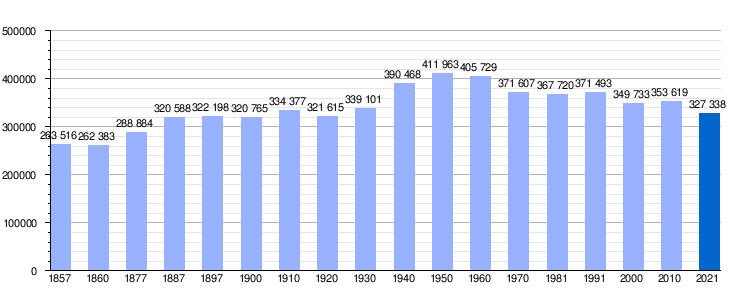 |
Source: Spanish National Statistical Institute - Graphical development by Wikipedia. |
In 2020 the province had 329,245 inhabitants, of whom 144,825 lived in the provincial capital. This is 44% compared to 19% of the total for the province in 1950. In 2018 the The province of Salamanca was the 8th in Spain in which there was a higher percentage of inhabitants concentrated in its capital (44.09% compared to 31.96% for the whole of Spain).
The province of Salamanca is one of the most affected by the risk of depopulation, which is known as emptied Spain, since for several decades there has been a continuous process of emigration to the cities, especially Madrid, Barcelona, Bilbao and other capitals such as Valladolid or Salamanca itself. During the beginning of the XXI century, the provincial capital did not register a large increase in population, which the towns in its area did metropolitan area, better known as Alfoz de Salamanca, which differs from most other metropolitan areas in Spain in that it is very compact. Its total extension does not reach 200 km² and the distance to the capital of the municipalities that compose it ranges from 0 km from Santa Marta de Tormes (the most populated municipality in the area after Salamanca capital) to 11 km from the municipality of Terradillos (El Encinar Urbanization).
After the city of Salamanca, only 9 municipalities in Salamanca have more than 5,000 inhabitants. They are Santa Marta de Tormes, Béjar, Ciudad Rodrigo, Villamayor de la Armuña, Carbajosa de la Sagrada, Peñaranda de Bracamonte, Villares de la Reina, Guijuelo and Alba de Tormes.
Administration and politics
Provincial Council
The government and administration of the province of Salamanca corresponds to the Provincial Council of Salamanca, as stated in the statute of autonomy of Castilla y León. Its headquarters have been in the Palacio de La Salina since 1884. Its president is Francisco Javier Iglesias of the PP.
It has powers in the field of advice, cooperation and assistance to municipalities. It also provides supra-municipal services of a provincial nature. Its composition is established by indirect election based on the results of the municipal elections in all the 362 municipalities of Salamanca, distributed proportionally among the judicial districts that comprise it.
| Political party | 2019 | 2015 | 2011 | ||||||
|---|---|---|---|---|---|---|---|---|---|
| % | Votes | Provincial Deputies | % | Votes | Provincial Deputies | % | Votes | Provincial Deputies | |
| Popular Party (PP) | 42,44 | 81 054 | 13 | 43,72 | 82 554 | 13 | 53,52 | 107 210 | 16 |
| Spanish Socialist Workers Party (PSOE) | 32,25 | 61 599 | 10 (1 non-adscribed) | 29,41 | 55 524 | 9 | 31,43 | 62 972 | 9 |
| Citizens (Cs) | 12,54 | 23 944 | 2 | 9.63 | 18 180 | 2 | - | - | - |
| We win Salamanca-Unidos Podemos | 3.12 | 5956 | - | 5,29 | 9990 | 1 | - | - | - |
| United Left (IU) | 0.55 | 1041 | - | 2.46 | 4637 | 0 | 3,03 | 6072 | 0 |
According to article 204 of Organic Law 5/1985, of June 19, on the General Electoral Regime, provinces with fewer than 500,000 inhabitants, such as Salamanca, will have a Provincial Council made up of 25 deputies provincial.
Autonomous government
The territorial delegation of the Junta de Castilla y León has its headquarters at Calle del Príncipe de Vergara, 53-71, Salamanca. The holder of the position is Bienvenido Mena Merchán. According to article 43.1 of Law 3/2001, of July 3, he represents the Board and each of the Ministries.
The province of Salamanca elects eleven representatives in the Cortes of Castilla y León. In the 2011 regional elections, Alfonso Fernando Fernández Mañueco, Francisco Julián Ramos, Julio Santiago Delgado, María Concepción Miguélez, María Josefa García, Purificación Pozo García and Salvador Cruz García were elected for the PP and Ana María Muñoz, Fernando Pablos Romo, Juan Luis Cepa Álvarez and Mª del Rosario Gómez for the PSOE. In the 2015 regional elections, María Josefa García Cirac, Alfonso Fernando Fernández Mañueco, María Lourdes Villoria López, Salvador Cruz García, Francisco Julián Ramos Manzano and María Concepción Miguélez Simón for the PP, Fernando Pablos Romo, Ana María Muñoz de la Peña were elected González and Juan Luis Cepa Álvarez for the PSOE and David Castaño Sequeros and Manuel Hernández Pérez for Ciudadanos. In the 2019 regional elections, Salvador Cruz García, Rosa María Esteban Ayuso, Alfonso Fernando Fernández Mañueco and María del Carmen Sánchez Bellota were elected for the PP, Juan Luis Cepa Álvarez, María del Carmen García Romero, Fernando Pablos Romo and Rosa María Rubio Martín for the PSOE and David Castaño Sequeros and María Montero Carrasco for Ciudadanos.
| Political party | 2022 | 2019 | 2015 | 2011 | 2007 | ||||||||||
|---|---|---|---|---|---|---|---|---|---|---|---|---|---|---|---|
| % | Votes | For | % | Votes | For | % | Votes | For | % | Votes | For | % | Votes | For | |
| Popular Party (PP) | 38,90 | 65 163 | 5 | 38,60 | 73 439 | 4 | 41,53 | 77 685 | 6 | 56.89 | 113 182 | 7 | 53,00 | 113 509 | 7 |
| Spanish Socialist Workers Party (PSOE) | 29,51 | 49 443 | 3 | 33,33 | 63 413 | 4 | 25,28 | 47 293 | 3 | 28,95 | 57 605 | 4 | 37,60 | 80 523 | 4 |
| Citizens (Cs) | 4.96 | 8311 | 0 | 15,60 | 29 681 | 2 | 13,31 | 24 907 | 1 | - | - | - | - | - | - |
| Vox | 18,02 | 30 192 | 2 | 4.78 | 9086 | 0 | 0.77 | 1448 | 0 | - | - | - | - | - | - |
| We can. | 3,42 | 5736 | 0 | 3,95 | 7524 | 0 | 10,76 | 20 135 | 1 | - | - | - | - | - | - |
| United Left (IU) | We can | We can | We can | 1,34 | 2556 | 0 | 2.99 | 5594 | 0 | 3,21 | 6395 | 0 | 2.24 | 4802 | 0 |
| Union Progreso and Democracy (UPyD) | - | - | - | - | - | - | 1.49 | 2782 | 0 | 3,03 | 6020 | 0 | - | - | - |
| Coalition SI for Salamanca (SI)-Unión del Pueblo Salmantino (UPSa) | - | - | - | - | - | - | - | - | - | 1.86 | 3700 | 0 | 3.72 | 7965 | 0 |
Alfonso Fernández Mañueco has been the president of the Junta de Castilla y León since July 12, 2019. He has been a solicitor in the Cortes of Castilla y León since June 17, 2003, while combining it with his position as mayor of Salamanca, from 2011 to 2018.
Central government
The sub-delegation of the Government in the province has its headquarters at Calle Gran Vía, 31, Salamanca. The holder of the position is Mª Encarnación Pérez Álvarez. According to article 75 of Law 40/2015, of October 1, the sub-delegates of the Government are responsible for: a) Carrying out the functions of communication, collaboration and cooperation with the respective Autonomous Community and with Local Entities and, in particular, report on the incidence in the territory of state funding programs. Specifically, they are responsible for: 1. Maintaining the necessary relations of cooperation and coordination of the General State Administration and its public Bodies with that of the Autonomous Community and with the corresponding local Entities in the area of the province. 2nd Communicate and receive all the information required by the Government and the governing body of the Autonomous Community. It will also carry out these functions with the local Entities in its territorial scope, through their respective Presidents. b) Protect the free exercise of rights and freedoms, guaranteeing citizen security, all within the state's jurisdiction on the matter. For these purposes, it will direct the State Security Forces and Bodies in the province. c) Direct and coordinate civil protection within the province. d) Direct, where appropriate, the integrated services of the General State Administration, in accordance with the instructions of the Government Delegate and the corresponding Ministries; and promote, supervise and inspect non-integrated services. e) Coordinate the use of the material means and, in particular, of the administrative buildings in the territorial scope of its competence. f) Exercise the sanctioning power and any other conferred by the regulations or that is decentralized or delegated to them.
The province of Salamanca elects four representatives in the Congress of Deputies. In the 2011 general elections, Gonzalo Robles Orozco, José Antonio Bermúdez de Castro and María Jesús Moro were elected for the PP and Jesús Caldera Sánchez-Capitán for the PSOE. In the 2015 general elections, José Antonio Bermúdez de Castro and María were elected Jesús Moro Almaraz for the PP, David Serrada Pariente for the PSOE and Pablo Yáñez González for Cs. In the 2016 general elections, José Antonio Bermúdez de Castro, María Jesús Moro Almaraz and Bienvenido de Arriba Sánchez for the PP and David Serrada were elected Pariente for the PSOE. In the general elections of April 2019, José Antonio Bermúdez de Castro and María Jesús Moro Almaraz were elected for the PP, David Serrada Pariente for the PSOE and José Antonio Mirón Canelo for Cs. In the general elections of November 2019, José Antonio Bermúdez de Castro and María Jesús Moro Almaraz were elected for the PP, David Serrada Pariente for the PSOE and Víctor Guido González Coello of Portugal for Vox.
| Political party | 2019 (2) | 2019 (1) | 2016 | 2015 | 2011 | ||||||||||
|---|---|---|---|---|---|---|---|---|---|---|---|---|---|---|---|
| % | Votes | Deputies | % | Votes | Deputies | % | Votes | Deputies | % | Votes | Deputies | % | Votes | Deputies | |
| Popular Party (PP) | 34,82 | 67 249 | 2 | 28,56 | 60 154 | 2 | 48,24 | 97 672 | 3 | 42,67 | 89 375 | 2 | 60.04 | 128 887 | 3 |
| Spanish Socialist Workers Party (PSOE) | 29,36 | 56 710 | 1 | 28.17 | 59 331 | 1 | 21,36 | 43 252 | 1 | 21.75 | 45 593 | 1 | 26,24 | 55 331 | 1 |
| Citizens (Cs) | 8,64 | 16 682 | 0 | 20,69 | 43 580 | 1 | 15,74 | 31 878 | 0 | 16,82 | 35 242 | 1 | - | - | - |
| Vox | 18,06 | 34 883 | 1 | 12,64 | 26 631 | 0 | - | - | - | 0.39 | 822 | 0 | - | - | - |
| We can. | 6.92 | 13 357 | 0 | 7.87 | 16 575 | 0 | 12,56 | 25 441 | 0 | 12,29 | 25 743 | 0 | - | - | - |
| Union Progreso and Democracy (UPyD) | - | - | - | - | - | - | 0.34 | 683 | 0 | 0.80 | 1669 | 0 | 6.18 | 13 276 | 0 |
| Izquierda Unida (IU) - Unidad Popular (UP) | We can | We can | With the United | 3.35 | 7017 | 0 | 4,31 | 9256 | 0 | ||||||
The province of Salamanca also elects four representatives in the Senate. In the 2011 general elections, Isabel Jiménez García, José Muñoz Martín and Julián Lanzarote were elected for the PP and Elena Diego for the PSOE. In the 2015 general elections, Gonzalo Jesús Robles Orozco, Francisco Javier Iglesias García and Esther Basilia del Brio González were elected for the PP and Rosa María López Alonso for the PSOE. In the 2016 general elections, Gonzalo Jesús Robles Orozco, Francisco Javier Iglesias García and Esther Basilia del Brío González for the PP and Rosa María López Alonso for the PSOE. In the general elections of April 2019, Bienvenido de Arriba Sánchez, Gonzalo Jesús Robles Orozco and Esther Basilia del Brío González were elected for the PP and María Elena Diego Castellanos for the PSOE.
Local action groups
In Salamanca there are the Association for the Development of the Ciudad Rodrigo Region (ADECOCIR), the Association for the Development of the West Zone of Salamanca (ADEZOS), the Association for the Rural and Economic Development of the Regions of Campo Charro Alba de Tormes y Guijuelo (ADRECAG), the Association for the Integral Development of the Sierras de Salamanca (ADRISS) and the Association for Endogenous Rural Development of the Northeast Territory of Salamanca. They manage a significant amount of the regional budgets, provincial and European.
Territorial organization
Municipalities
Currently the province of Salamanca is divided into 362 municipalities or town halls that administer one or several towns.
It is the second Spanish province with the largest number of municipalities, behind Burgos. Most of them have fewer than 1,000 inhabitants.
Minor local entities
In 17 municipalities of Salamanca, 19 minor local entities have been established. These are Águeda del Caudillo (Ciudad Rodrigo), Aldeaseca de Armuña (Villares de la Reina), Bercimuelle (Puente del Congosto), Boadilla (La Fuente de San Esteban), Bocacara (Ciudad Rodrigo), Campillo de Salvatierra (Guijuelo), Cespedosa de Agadones (Herguijuela de Ciudad Rodrigo), Fuentebuena (Béjar), Galleguillos (Gajates), Guadapero (Serradilla del Arroyo), Herrezuelo (Anaya de Alba), La Lurda (Garcihernández), Mozodiel de Sanchiñigo (Villamayor), Navagallega (Membribe de la Sierra), Santa María de los Llanos (Santibáñez de la Sierra), Turra de Alba (Pedrosillo de Alba), Valdesangil (Béjar), Villanueva de los Pavones (La Orbada) and Villarejo (Zamarra).
Commonwealths
The province of Salamanca has 32 associations. They are groups of several municipalities that manage services such as water or garbage. The same municipality can belong to one or several associations. There are also municipalities not attached to any of them.
- Aguas de Santa Teresa
- Aguas Águeda-Azaba
- High Agueda
- Alto Tormes
- Arribes of the Duero
- Azud de Villagonzalo de Tormes
- Burguillos
- Oven Head
- Calvarrasa de Arriba-Terradillos
- Campo Charro
- Duero Centre
- The Abadengo
- Four Ways
- Béjar reservoir
- Entresierras
- Guijuelo and its communal environment
- The Armuña
- Las Dehesas
- Ledesma region
- Linares de Riofrío and its surroundings
- Margain
- Pantano de Santa Teresa
- Peñaranda
- Bridge The Union
- Banks of the Agueda, Yeltes and Agadon
- Ruta de la Plata
- Routes of Alba
- Sierra de France
- Earths of the Storm
- Vitigudino
- Yeltes
- Cantalapiedra Area and Las Villas
Judicial parties
The judicial needs of the municipalities of the province of Salamanca are managed in 5 cities that make up 5 judicial districts.
- Béjar judicial party
- Judiciary Party of Ciudad Rodrigo
- Peñaranda Judicial Party
- Judicial Party of Salamanca
- Vitigudino Judicial Party
Country
The regions of the province of Salamanca are historical-traditional, cultural and/or geographical demarcations that do not have any administrative function. The only administrative demarcations of the province are those of the municipalities, judicial districts and associations. The same thing happens throughout Castilla y León, since the only region recognized by law is El Bierzo. If we ignore the sub-regions, in the province of Salamanca there are 11 main regions.
- Campo de Salamanca
- District of Ciudad Rodrigo
- Guijuelo region
- Vitigudino region
- The Armuña
- Las Villas
- Sierra de Béjar
- Sierra de France
- Land of Alba
- Land of Ledesma
- Land of Peñaranda
The region of Vitigudino has the subregions of El Abadengo, Las Arribes, Tierra de Vitigudino and La Ramajería, the region of Ciudad Rodrigo with those of La Socampana, Campo de Argañán, Campo de Yeltes, Campo de Agadones, Campo de Robledo and El Rebollar, Tierra de Peñaranda with Las Guareñas and the region of Guijuelo with Entresierras, Salvatierra and Alto Tormes. In total, 22 counties and sub-counties are counted, although there are other areas that could also be classified as sub-counties but that do not have a prominent entity, that is, they are either very small or do not have a clear demarcation. This is the case of the valley of Las Batuecas, Las Quilamas and La Calería (Sierra de Francia), La Huebra (Campo de Salamanca), Campo de Azaba (Campo de Argañán) and Alto Alagón and Las Bardas (Entresierras).
| People | Year of incorporation |
|---|---|
| The Pool | 2014 |
| Mogarraz | 2014 |
| Candelario | 2015 |
| Ciudad Rodrigo | 2016 |
| Miranda del Castañar | 2017 |
| Ledesma | 2018 |
The Most Beautiful Towns in Spain
With six towns, Salamanca is the second Spanish province with the most towns in the association of The Most Beautiful Towns in Spain, only behind the province of Teruel, which has seven.
Economy
Energy
In the field of hydroelectric energy, Salamanca is the first Spanish province in terms of installed capacity, largely due to the fact that the Aldeadávila dam has the hydroelectric power plant with the largest productive capacity in the country. With 1,139 MW, it is only surpassed in installed power by the Cortes de Pallás-La Muela complex (Valencia). The other important plant in Salamanca is the Almendra dam, with 810 MW installed.
In the field of wind energy, it is the Castilian and Leonese province with the fewest facilities, due in large part to the numerous protected spaces it has, also to the validity of an outdated provincial wind plan, which dates from 1998. Salamanca has with the Bandeleras (36 MW), Las Dueñas (31.45 MW), Los Concejiles (11.69 MW), Matabuey (16.2 MW), Teso Santo (50 MW) and Rodera Alta (34 MW) wind farms.
Regarding solar energy, it should be noted that the plant located between the municipalities of Zarapicos and San Pedro del Valle was inaugurated in 2007 as the second largest in the world. Considering the speed with which new solar plants are built, it will soon be surpassed.
Salamanca does not have thermal or nuclear power plants, but the National Uranium Company (ENUSA) has the nuclear fuel factory in Juzbado that supplies uranium to all the nuclear power plants in Spain. Also to the reactors of nine French. It exports 70% of what it manufactures.
Services
Transportation
Road network
Of the road network in Salamanca, the Avila-Salamanca Highway (A-50), the Castilla Highway (A-62) and the Ruta de la Plata Highway (A-66) stand out especially. The last two are part of the European routes E80 and E803. Salamanca capital has the SA-20 and SA-11 ring roads.
Railway
The railway network in the province includes the lines Salamanca - Fuentes de Oñoro - Portugal, Salamanca - Ávila - Madrid and Salamanca - Medina del Campo - Valladolid. There is also the Zamora - Salamanca - Plasencia line and the La Fuente de San Esteban - Barca de Alba line, which are completely abandoned. The latter has been declared an Asset of Cultural Interest since the year 2000.
Air transportation
Salamanca is one of the four Castilian and Leonese cities that has an airport facility, the Matacán Airport. It offers flights to Barcelona throughout the year and to Palma de Mallorca, Menorca, Malaga, Gran Canaria, Tenerife and Lanzarote during the summer. It was the headquarters of Iberia during the Spanish civil war and housed the National School of Aeronautics between 1974 and 1993, later succeeded by SENASA and Adventia.
Culture
Heritage
Parties
The city of Salamanca celebrates the festivities of its patron saint San Juan de Sahagún on June 12 and those of its patron saint Virgen de la Vega on September 8. It also celebrates other very famous ones such as Monday of waters and Holy Week, declared of international tourist interest.
In the rest of the province, the Béjar Corpus Christi procession with the Men of Moss is of international tourist interest. Of national tourist interest the Carnival of the Bull of Ciudad Rodrigo and the Loa de La Alberca. Of regional tourist interest are the festival of El Noveno de San Felices de los Gallegos in mid-May, the typical wedding of Candelario on the second Sunday of August, the Corpus Christi of La Alberca, the typical slaughter of Guijuelo during January and February, La Charrada de Ciudad Rodrigo every holy Saturday and the patron saint festivities of Santa Teresa de Alba de Tormes in mid-October.
Other notable festivities are the offertories in La Alberca, Mogarraz, Cepeda and San Martín del Castañar, the Sequeros Christmas Petition, the Ledesma Frights, Macotera's Misa del Gallo, La Robra in El Cabaco, the San Silvestre in Aldea del Obispo and La Choriza in Puerto Seguro.
On February 5, the festival of Las Águedas is celebrated in many towns in the province. The one in Miranda del Castañar is especially showy. Other common festivals in many towns are those animated by running of the bulls and bullfights. They are celebrated in Alba de Tormes, Aldeadávila de la Ribera, Cepeda, Ciudad Rodrigo, Fuenteguinaldo, Gallegos de Argañán, Ledesma, Lumbrales, Los Santos, Ledesma, Lumbrales, Macotera, Martín de Yeltes, San Felices de los Gallegos, Sancti-Spíritus, Saucelle, Villarino de los Aires, Villavieja de Yeltes, Vilvestre and Vitigudino.
Gastronomy
Its products include Guijuelo ham, the most famous denomination of origin in the province. Also recognized, although less famous, are Morucha meat, Iberian pork from Salamanca, Charra beef, Arribes cheese from Salamanca, farinato from Ciudad Rodrigo, lentil from La Armuña, chickpea from Pedrosillo and the cherry from the Sierra de Francia. Typical dishes are famous for hornazo, which in Cepeda is covered in sugar, serrano lemon and garlic soup. Other lesser known are the suckling pig, suckling pig, chanfaina, lamb legs, Bejarano calderillo, maimón bun, yolk chochos and Ledesma donuts.
Folklore
The charro suit is commonly known and used in festivities throughout the province, although in some regions they have their own traditional costume, as is the case in Sierra de Francia, El Rebollar, La Ribera, La Armuña and the Sierra de Béjar. The latter is the main protagonist of the typical Candelario wedding, a festival of regional tourist interest.
Languages
Castilian is the only official language in the entire province of Salamanca but other very minority ones are also spoken such as Leonese and Portuguese.
Centuries ago the domain of the Leonese was relatively extensive. It was the language of the settlers who settled in the province after the reconquest and is recognized by the Junta de Castilla y León in its Statute of Autonomy due to its greater presence in other provinces, especially in León, somewhat less in Zamora's. In Salamanca, there are still some residues, to a greater or lesser degree, to the west and south, in La Ribera, La Ramajería, El Abadengo, Campo de Robledo, El Rebollar, Los Agadones, Sierra de Francia and the Sierra de Béjar. In most cases, it is about the use of certain words and linguistic expressions of Leonese or derived from Leonese since it is practically only preserved as a language in the region of El Rebollar. In it, its inhabitants use it on a daily basis and consider that it is a valuable cultural heritage to protect, to such an extent that even in some of its municipalities they label the name of the streets bilingually. It is popularly known as habla de El Rebollar or palra d'El Rebollal and is usually classified as Extremadura, which has affinities with the Asturian language.
The cultural influence of the prestigious University of Salamanca was probably the cause of the rapid Castilianization of this province, which divided and isolated the Leonese domain in two. This eliminated the geographical continuity that surely existed with the dialects of the south of the province, which today are classified as Extremadura.
In 1492, Antonio de Nebrija wrote and published the first grammar of the Castilian language in Salamanca, making the city a benchmark for this language. Today it continues to be, but for other reasons, and that is that foreign students choose it as a priority over other cities to learn Spanish. Due to this and other milestones, it is included in the Camino de la Lengua Castilana.
On the other hand, and due to the border nature of the province of Salamanca, the Portuguese language is commonly spoken together with Spanish in some areas of Campo de Argañán neighboring Portugal, especially in the towns of La Alamedilla and Sources of Onoro.
Sports
- The Salamanca Sports Union played 12 seasons in the First Division of Spain in the 1970s to 1990, as well as 34 seasons in the Second Division, but was dissolved in 2013.
- The Avenida Perfumerías is a benchmark in the Spanish and European feminine basketball.
- The ball by hand is an obvious traditional sport of the province of Salamanca, as there are numerous frontons or trims for their villages.
- The calva, another of its traditional sports, formerly owned by pastors.
Media
On television there is a provincial disconnection from Castilla y León Televisión through La 8.
In the press, the most prominent newspapers are La Gaceta de Salamanca, Salamanca 24 horas, Salamanca RTV al día and Salamanca Tribune. The latter closed its print edition in 2011 and El Adelanto de Salamanca ceased its full activity in 2013. Both Salamanca 24 horas and Salamanca RTV al día (formerly Diario de Salamanca) were born on the internet, the latter betting on the creation of regional news portals, independent of the main newspaper. El Norte de Castilla, dean of the Spanish press and leader in Castilla y León, inaugurated a new edition of the newspaper in Salamanca in 2013.
Notable people
Contenido relacionado
Life is Beautiful
Olympia of Epirus
1982
